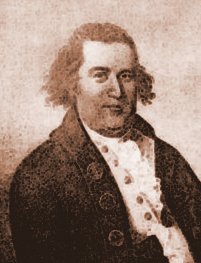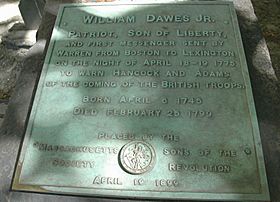William Dawes facts for kids
William Dawes Jr. (April 6, 1745 – February 25, 1799) was an American patriot who played a key role in the start of the American Revolution. He was one of several brave riders who alerted colonial soldiers, called minutemen, that British troops were on the move in April 1775. This warning led to the Battles of Lexington and Concord. While his friend Paul Revere is more famous, Dawes's ride was just as important to the American cause.
Contents
Early Life in Boston
William Dawes was born in Boston, Massachusetts, on April 6, 1745. As a young man, he worked as a tanner, a person who makes leather from animal skins. He was also an active member of Boston's local army, known as the militia.
In 1768, he married Mehitable May. At his wedding, he proudly wore a suit made entirely in North America. This was a way to protest British taxes. At the time, many colonists, called Whigs, were unhappy with British rules. They encouraged people to buy American-made goods instead of British ones to show their support for independence.
A Patriot in the Militia
Dawes was a dedicated member of Boston's militia. He and his father belonged to a special group called the Ancient and Honorable Artillery Company of Massachusetts. He was known for his bravery and cleverness in opposing the British.
Hiding the Cannons
In 1774, Dawes likely helped the Boston militia hide four small cannons from the British. The colonists wanted to keep their weapons safe in case they needed to fight.
On another night, Dawes and some friends did something even more daring. They stole two cannons from a building that was being watched by a British guard. They snuck the cannons out a back window and hid them in a woodbox at a nearby schoolhouse. When the British came looking for the cannons, the schoolmaster pretended he knew nothing, even while resting his feet on the box where they were hidden. Dawes hurt his wrist during the escape, but the mission was a success.
The Famous Midnight Ride
On the night of April 18, 1775, the Patriot leader Dr. Joseph Warren discovered that British soldiers were about to march from Boston. He needed to warn two other important leaders, John Hancock and Samuel Adams, that they were in danger of being arrested.
Dr. Warren gave this important job to William Dawes. Dawes took the land route out of Boston, sneaking past British guards just before they closed off the city. At the same time, Paul Revere took a different route across the Charles River to deliver the same message.
The Ride to Lexington and Concord
Dawes and Revere both arrived in Lexington around midnight. After warning Hancock and Adams, they decided to ride on to the town of Concord. They knew the colonists had stored weapons and ammunition there.
Along the way, they met a young doctor named Samuel Prescott, who joined their ride. Suddenly, a group of British officers on horseback appeared and ordered them to stop. The three riders scattered in different directions. Revere was captured, but Prescott escaped and successfully warned the people of Concord.
Dawes also got away by tricking two officers. He galloped into a nearby yard and shouted as if he had other riders with him. Fearing an ambush, the officers stopped chasing him. In the confusion, his horse threw him off, and he had to walk back to Lexington.
Service in the American Revolution
Thanks to the warnings from Dawes, Revere, and Prescott, the colonial militias were ready for the British. They fought in the Battles of Lexington and Concord, which were the first battles of the American Revolutionary War.
During the war, Dawes served as a major in the Boston militia. He also worked as a quartermaster, which meant he was in charge of getting supplies like food and equipment for the Continental Army.
Later Life and Family
After the war, Dawes returned to his life in Massachusetts. His first wife, Mehitable, died in 1794. They had three children together. Dawes later remarried a woman named Lydia Gendall, and they had one child.
William Dawes died in Marlborough, Massachusetts, on February 25, 1799. He is thought to be buried in a family plot in Boston.
Why Isn't Dawes as Famous as Revere?

You have probably heard of Paul Revere, but why not William Dawes? The main reason is a famous poem called "Paul Revere's Ride" by Henry Wadsworth Longfellow. The poem tells an exciting story but focuses only on Revere, leaving out Dawes and Prescott.
In 1896, a writer named Helen F. Moore wrote her own poem about Dawes to remind people of his bravery. Historians agree that Dawes and Prescott were just as successful as Revere in their missions.
Today, there are memorials that honor Dawes for his heroic ride. In Cambridge, Massachusetts, there is a spot called Dawes Island. Bronze horseshoes are set in the sidewalk to show the path he rode.
Notable Descendants
William Dawes's family continued to be important in American history. His great-grandson, Rufus Dawes, was a general in the Civil War. One of Rufus's sons, Charles G. Dawes, became the Vice President of the United States, serving with President Calvin Coolidge from 1925 to 1929.
See also
- The Charles G. Dawes House has portraits of William Dawes and his wife, Mehitable May, in its collection.
- Israel Bissell
- Sybil Ludington



